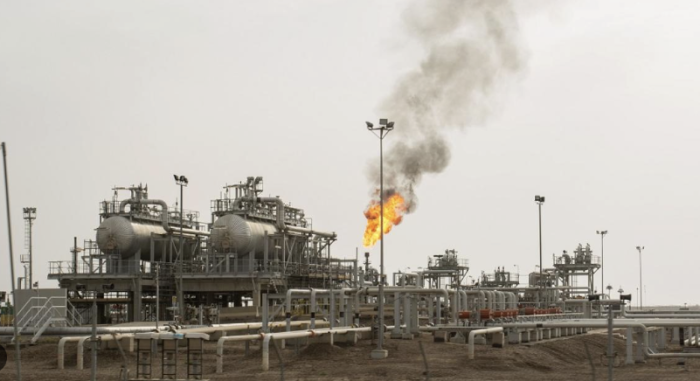America is confused about the fields shared between Iraq and Iran... huge, uncontrollable oil flows
KTFA:
Don961: America is confused about the fields shared between Iraq and Iran... huge, uncontrollable oil flows
March 28, 2024
Baghdad/Al-Masala Al-Hadath: Economist Simon Watkins said in a report published by the American Oil Price website that many unofficial flows emerged from increases in the oil fields shared between Iran and Iraq, so that it makes sense for the two countries to work to raise these increases significantly.
There are many fields shared between the two countries, the most prominent of which are Azadegan (on the Iranian side) / Majnoon (on the Iraqi side), Azar (Iran) / Badra (Iraq), Yadavoran (Iran) / Sinbad (Iraq), and Naft Shahr (Iran) / Naft Khana. (Iraq), Dehlran (Iran)/Abu Ghurab (Iraq), Baydar Gharb (Iran)/Fakka Field (Iraq), and Arvand (Iran)/South Abu Ghurab (Iraq).
The new development initiative between Iran and Iraq will include assigning local companies, most of which are linked to the Iranian Revolutionary Guard or factions allied with Iran in Iraq, and their mission is to increase the return on oil extraction from the smaller joint fields, while Russian and Chinese companies will take the lead in the larger fields.
The idea of limiting local companies to smaller fields is to allow them to develop their oil extraction techniques (with help from Russia and China) so that they can guarantee the average recovery rates of 3.5 percent they have achieved at their designated sites.
A well-known Western oil company laid out plans before sanctions were reimposed on Iran in 2018. It aimed to increase recovery rates in a group of these smaller fields to more than 12.5 percent within 12 months of starting them (from the then average of 2.5 percent). 20 percent after a year, then to about 50 percent within three years.
The Iranian Ministry of Oil hoped that increasing the technical capabilities of local companies would enable them to increasingly participate in the development of larger fields, enabling Tehran to reduce the discount on oil sold to China as part of comprehensive field development packages signed with its companies.
This includes larger fields as well, where the financial potential for even relatively small increases in the rate of oil extraction is enormous.
The combined oil-rich fields in the West Karun region, which includes the North Azadegan, South Azadegan, North Yaran, South Yaran and South Yadavaran fields, for example, contain at least 67 billion barrels of oil and enjoy an average recovery rate that currently stands at only 5 percent.
This is compared to the average recovery rate across the Kingdom of Saudi Arabia, which is at least 50 percent.
An Iranian source told Oil Price: “The recoverable reserves figure increases by 670 million barrels, or about $34 billion in revenue for every 1 percent increase in the average recovery rate across West Karon, even if we were only going to sell at $50 a barrel.”
“Raising the recovery rate to 25 percent across West Karun over a 20-year contract period, thanks to sound joint development, is expected to add $838 billion in revenue to Iran.”
He stressed that the average West Karon oil production today is about 360,000 barrels per day, and sometimes reaches 380,000 barrels per day, while it did not exceed 120,000 barrels per day during 2017.
The main part of the “Comprehensive Cooperation Agreement between Iran and China for 25 years” was for Chinese companies to raise collective production from the West Karun fields by no less than 500 thousand barrels per day.
This is not difficult, as the average lifting cost remains between one and two dollars per barrel of crude oil in Iran itself and in Saudi Arabia and Iraq. But Chinese companies have not yet achieved any meaningful increases, which may be another reason for Iran and Iraq's desire to increase their capabilities to exploit their vast oil resources.
The fields shared between Iran and Iraq have also been invaluable to Tehran's successful efforts to avoid oil sanctions from the United States or Europe for years. Oil is often being explored on the non-sanctioned Iraqi side of the border across the border from the same oil reservoirs as oil exploration continues on the sanctioned Iranian side. This sometimes happens even through extended drilling.
Even if the Americans, Europeans, or any of their most trusted appointees put people at every platform across every common field in Iraq, they would not be able to know whether the oil extracted is from the Iraqi side or from the Iranian side.
Thanks to sound joint development, raising the recovery rate to 25 percent across West Karun over a 20-year contract period is expected to add $838 billion in revenue to Iran.
This made it possible for Iranian oil to be exported to Iraq and shipped to anywhere in the world it was needed for decades.
Further layers of complexity were added to further obscure the true origin of the exported oil. Simple but effective methods include turning off the transponder used by the ship's automatic identification systems, making it difficult to track. link
